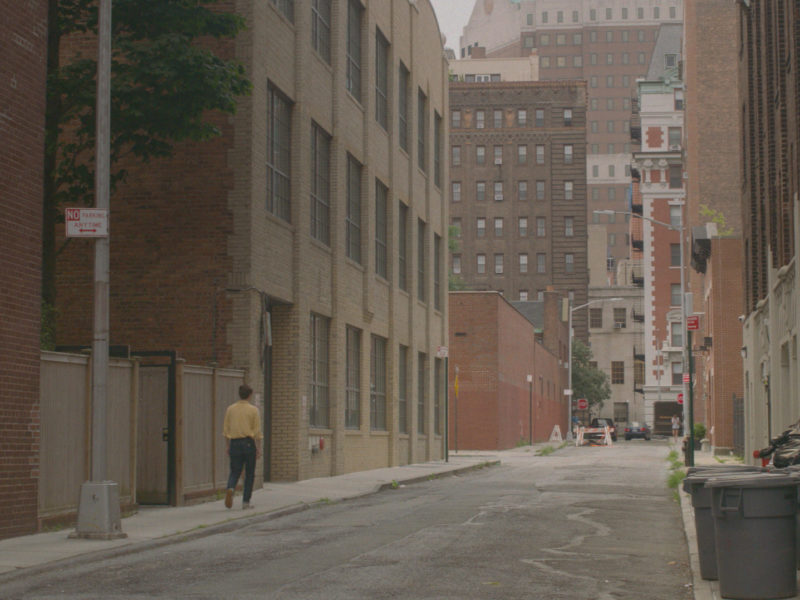It can come across as the most dismissive thing a critic might say. You enjoyed a director’s first film, and you’ll be really interested to see what they do next. But in the case of Ricky D’Ambrose’s hour-long Notes on an Appearance, it’s possibly the most appropriate comment. Having been struck by the film when I first saw it in Berlin in February, I’m certainly intrigued to see where this young writer-director goes from here, because I can’t quite imagine where that might be—nor can I quite pin down what it is that makes Notes so alluring. The effect of this film is a bit like hearing someone tell you a story that refuses to gel into a stable narrative shape, in a voice that slips in and out of focus; you don’t quite know where it’s heading, so the only adequate response seems to be to say, “Yes, go on, I’m listening…” If that makes D’Ambrose’s project sound whimsical or vague, that’s not at all the case. What’s striking about Notes is its determined rigor—and perhaps a certain cerebral show-offiness, although that’s a characteristic that the film appears to send up in itself. At any rate, this film hits the viewer—assuming the viewer isn’t totally resistant to its unapologetically rarefied appeal—as a sharp, bracing draft of icy water. The skeletal narrative concerns a young American named David (Bingham Bryant) who’s been spending time in Milan with a woman named Madeleine (Tallie Medel), before briefly returning home to Chappaqua, where he seems to have a strained relationship with his parents. He then goes to Fort Greene, Brooklyn, to stay with his old college friend Todd (Keith Poulson) and help out on his current project—a book Todd is writing on the late American historian and Yale academic Stephen Taubes. Taubes has accrued a furiously committed following; his denunciation of the “abyssal fantasy of liberalism” and praise of terrorists for their desire to eradicate “a world of soul-killing mediocrity” have made him a highly controversial figure, with rumors of anti-Semitism in the air. Taubes is entirely fictional, but D’Ambrose has contrived to make us believe that he might be real by painstakingly mocking up covers of his apocryphal books, some of them published by real-life imprint Verso (among them Everything Is Permitted: History at the Abyss and Repress/Redress/Progress) as well as assorted writing on him in publications such as The New York Times, the London Review of Books, and The New Yorker (a plausible-looking feature by Louis Menand, no less). Taubes is an unnerving background presence, one newspaper even reporting that a rally of his followers has resulted in two deaths; he sounds like a nightmare cross between Paul de Man and Steve Bannon.
Then David disappears. It’s the unexplained void he leaves behind—L’Avventura-style, more or less—that structures the rest of the film, which executes an abrupt but elegant shift to Todd’s attempts to find him, along with other characters’ digressive moves to stage center, as in Madeleine’s impromptu encounter with a young man who’s about to travel to Hungary. The narrative, fairly clear-cut although it resists resolution, is only one element of Notes—something that travels in parallel, if you like, with the film’s style. Notes is executed tersely, telegraphically, in a chain of usually brief shots—static images, for the most part. Shot by Bart Cortright in 4:3 ratio and edited by D’Ambrose himself (also responsible for the production design), the film comes across as a sort of collage of diverse elements. There’s the action, such as it is, a series of comings and goings and rather formal static studies (the characters, street scenes, table-top compositions); a series of interpolated video sequences, some of them very roughly shot on archaic formats (supposedly extracts of Taubes’s recordings of his international travels, and one presumably from David’s trip to Milan); together with a series of still rostrum camera shots of maps, documents, writings. These include both sides of David’s postcard from Milan, his diaries with notes on his daily expenses, a house blueprint, assorted street and subway maps. In terms of sound, there are fragments of voiceover from David, which soon drop out; ambient sound (crowd, birds, sea) that don’t always relate to what we’re seeing; and incongruously jaunty passages from Rossini (The Barber of Seville) and Weber. Then there are all the meticulously counterfeited articles, book covers, and other material pertaining to Taubes. At one point, we realize that a mass of such material actually comprises the contents of a research folder that David is perusing: I think the only time that I’ve seen a file “unpacked” like this on screen before. It’s as though the film itself, in all its simplicity, is a densely packed folder that gradually but generously opens up to curious scrutiny. Overall, D’Ambrose presents his images, sounds and other impressions and pieces of information like a set of documents: displayed in a particular, seemingly logical order, but presented without obvious signs of continuity, left to us to connect, re-order, interpret. Certain images recur repeatedly: the exteriors of a café and a dry cleaner’s, the last street that David walks down, various tabletops on which objects are arranged like spartan still lives—a cup of black coffee, a glass of water, a paperback copy of Spinoza or Wyndham Lewis (D’Ambrose always places his books on tables just so). The effect is like a coolly detached graphic novel, its frames sometimes overloaded with language but more often laconic, as in the shots of David or Todd, in pale yellow and beige shirts, lying alone on their beds or sitting at tables, practically dissolving into their similarly color-drained backgrounds. In a very different comic-strip style, D’Ambrose also sometimes throws in backgrounds of incongruously lurid color, bright red, blue or yellow, and punctuates the film with frames of lime green.
There are moments when the film takes on a more overt, even abrasive edge of satire. At one point, we see Todd’s friend, possibly girlfriend, Karin (Madeleine James) taking part in a panel discussion on translation: attended by a group of earnest, solemn-faced young people who speak in droning, intense monotones, it’s an orgy of highbrow literary and filmic namedropping (Dalkey Archive Press, Danilo Kiš, Roberto Bolaño, New Directions, Fernando Solanas, Cinemascope…), as if D’Ambrose is daring us to stay on board or jump ship from this brainiac cruise. Many of the participants—their comments punctuated by stark, portentous organ chords—are seen only in three-quarter profile, or with backs of heads to camera (one is journalist and critic Violet Lucca, formerly a Film Comment staffer; also contributing a micro-cameo elsewhere is critic Glenn Kenny). Elsewhere, D’Ambrose takes us to an art world opening. We don’t see the works, only Todd and a young woman gazing at them, and the curatorial captions on the wall, choice mock-ups of International Art English. Among them, “playful dis-logic charms the viewer’s eye in an absurd and cyclical non-narrative,” or “Hassel utilizes abstraction to negotiate the space between geometry, symbolism and representation”—which, for all I know, may be very accurate descriptions of D’Ambrose is doing in his film. In his published work as a critic, D’Ambrose has name-checked Bresson and Eugène Green, and written on Straub-Huillet, which gives you an idea of the acting style he favors: blank, uninflected delivery by actors who tend not to move a great deal, and certainly not to project in any sense. He has also written a strongly argued polemic in The Nation against Instagram culture and the idea of off-the-peg “looks” supplanting genuine investigations of style. He has also filmed interviews with Chantal Akerman and Bruno Dumont. If that all suggests a hyper-sternness like that of his characters, there’s also a playful side to his style. His overall aesthetic in Notes, given this rambling story about young people with sketchily defined links between them, reminded me somewhat of Argentinian director Matías Piñeiro; then I realized that Poulson appeared in his Hermia & Helena, and Piñeiro is among those thanked in the end credits.
Because of the acting style, we can’t really draw any conclusions about these characters and what sort of people they might really be: the overall flatness means that they’re effectively presented as “Young Man 1,” “Young Woman 2,” in a radical hollowing-out of personality. But, partly because of their vulnerable-seeming youthfulness, we tend to give them the benefit of the doubt, despite their gratingly deadpan diction (Notes could be the flagbearer for an American style called “dronecore”). There’s one exception. Largely because of a single scene, a discussion with Todd, Karin—who outdoes the others for the dourness of her intonations—comes across as one of the most horrible characters I’ve recently encountered in a movie. She chides him for caring so much about David, tells him it’s time to stop looking for him: his disappearance, she says, is “a non-event… It bores me.” There are more important things to worry about, she says, like the work they have do on “the direction we want this country to go in.” You’re suddenly reminded that these people are acolytes of Taubes, whose apocalyptic pronouncements suggest that he’s a very dangerous guru indeed: it’s even rumored that his followers may have something to do with the death of a journalist. Taubes isn’t just a dispenser of the abstractions that fuel academic conferences. We’re talking about someone, after all, who decries the “lie [of] the sanctity of human life”—the kind of thought that has terrible effects in the real world. So where does this leave the people who follow him? There’s a sharp disconnect between the flat, etiolated presence of these young intellectuals and the reality of the violence that happens in the background of the story. Todd may be sympathetic to us because of his baby face and his tears of worry over David’s disappearance. That he’s passionately committed to Taubes’s thought is something that we might bear in mind as the last image of him fades slowly into darkness, leaving us to wonder—among other things—where D’Ambrose’s singular approach will lead him next. Like I said, I’ll be interested to see. Jonathan Romney is a contributing editor to Film Comment and writes its Film of the Week column. He is a member of the London Film Critics Circle.



